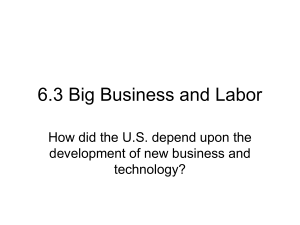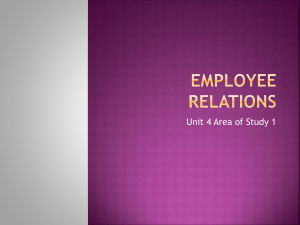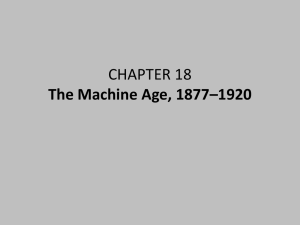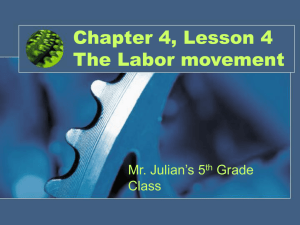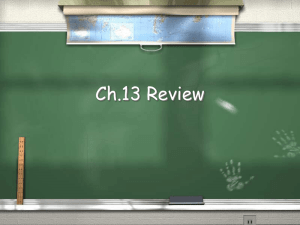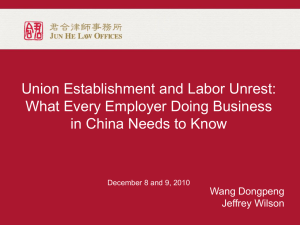Trade Unions in Russia, China and Vietnam
advertisement
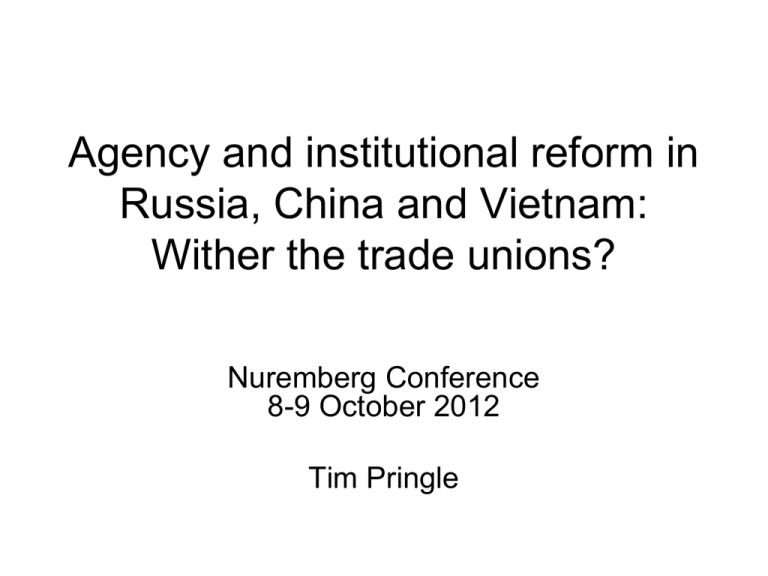
Agency and institutional reform in Russia, China and Vietnam: Wither the trade unions? Nuremberg Conference 8-9 October 2012 Tim Pringle Transition to capitalist employment relations • Transition from state to capitalist/permanent to contractual employment • Transition from state welfare to social insurance • Large lay-offs from SOEs – privatisation • China and Vietnam: massive growth of private and foreign-owned enterprises employing migrant workers on low wages, short or no contracts, long hours, poor health and safety • Russia: deep depression 1989-98, uneven recovery based on extractive industry since; FDI mostly in consumer goods for domestic market The challenge for trade unions • Conflict of interest between workers and employers – new role for trade unions • Need to represent workers’ interests in political processes • Need to represent workers in negotiation with employers • Need to defend workers against bad employers Political role of ‘post-socialist’ trade unions • Political role in all three countries is to administer state functions and to preserve social peace • Chinese and Vietnamese Party requires unions to prevent strikes and social unrest – by mediating between worker and employer – by channelling disputes into bureaucratic and judicial channels • Growing level of strikes in private sector in China and Vietnam means pressure from Party – to organise migrant workers – to extend union organisation to POEs and FIEs • Russian trade unions politically independent, but under pressure from ruling party to maintain social peace. Lower level of strikes and protests, so need to mobilise members to achieve political influence Legal Framework for unions • Extensive protective labour legislation • Provision for collective agreements • Bureaucratic-legal dispute resolution procedures • Legally enforced monopoly trade unions • Severely limited or no right to strike • Public order legislation/policing Weak workplace trade unions • Workplace trade unions dominated by management, perform management functions • Union has almost no capacity to monitor and enforce legislation and agreements or to represent or mobilise workforce • Workers have little confidence in their unions • Exceptions in all three countries: depend on – – – – – – personality of union president, strong labour market situation of workers, demographic structure of workforce, performance of enterprise, Type of ownership Position in global supply chain Bureaucratic regulation of labour relations • Unions prefer lobbying for laws and policies and legal-bureaucratic regulation • Sectoral/local/regional agreements – need for employers’ organisations; depend on political support from state authorities • Legal advice centres support the resolution of individual disputes, less effective for collective disputes Bureaucratic regulation and worker activism • Limited effectiveness of bureaucratic-legal representation • Workers have limited capacity to organise or mobilise, little confidence in unions • Workers act through illegal strikes and protests – collective bargaining by riot • Symbiosis of bureaucratic representation and workers’ self-organisation • Need to integrate workers into trade union through active and effective workplace organisation Harmonious workplace unions • Harmonious labour relations only possible where workplace trade union represents the union members and provides channels for representation/negotiation/bargaining • Effective workplace unions presuppose: – Collective labour dispute procedures, including the right to strike – Freedom of workers’ to organise themselves Who has the most strikes? • China: no right to strike; limited channels for legal resolution of collective disputes • Vietnam: right to strike, only following slow and complicated bureaucratic procedure, no legal strikes • Russia: strikes legal, following exhaustion of procedure for resolution of collective labour disputes Official number of strikes 2006 2007 Russia 8 7 Vietnam 387 540 China ???? ???? Resolving collective labour disputes in Russia • Collective labour disputes arise regarding negotiation or terms of collective agreements • Demands put forward by union or majority vote of a meeting of workers • Conciliation – arbitration – strike • Strike must be supported by majority of the labour force • Registration of a collective labour dispute usually sufficient to persuade employer to settle Freedom of association - Russia • 1990 TU Law gave equal rights to any trade union – proliferation of small alternative trade unions, especially sectional unions, encouraged by US funding • 2001 Labour Code gave majority trade union in each workplace monopoly representation rights, weakened alternative unions • Gives workers capacity to by-pass management-dominated union • Gives workplace union capacity to break with ineffective sectoral union • ‘In general the existence of the alternative trade unions is even helpful. Competition does not allow us to stagnate’ Mikhail Shmakov FNPR President • Alternative unions significant as a force for change rather than as replacement of traditional unions Effective workplace unions • Creating representative workplace unions – Election of trade union representatives – Widening participation in the union • Professionalisation of trade union officers – Training of workplace trade union officers – Trade union career path: salaries and promotion • Technical support for workplace trade unions: – Legal advice and representation – Support for collective bargaining – Inspections Trade union elections • Necessary but not sufficient condition for change • Means of removing the most ineffective leaders • Management and existing leadership can easily control elections: difficulty of alternative candidates emerging • Widening participation in union provides space for candidates to prove themselves • Build union from the base: teams and shops • Need appropriate pay, conditions and status for trade union officers at each level • Reconcile trade union elections and Party leadership within framework of trade union structures. Professionalising the union • Trade union identification with management in command economies was embedded in the pay, status and careers of trade union officers • In a market economy trade union officers are professional representatives of workers • Trade unions need new pay scales, professional training and career opportunities appropriate to their new role • Trade union officers should be paid by the union, not by management • Cost is a matter of trade union priorities Supporting the workplace union • Russia Regional committees: – Provide information/documentation – Provide link to and lobby local administration/inspectorates/political bodies – Provide legal advice and representation – Negotiate regional agreements – Support collective bargaining – Provide training, consultation meetings – Organise coordinated campaigns Supporting the workplace union • Vietnam – Short training courses for primary level cadres making use of ILO and support from foreign unions – Legal advice and education initiatives, including pressurising employers to allow workers and union officials to take part – Work with government departments and primary unions on inspections – Strike taskforces to assist in workplace wage negotiations – VGCL criticises government for delay in increasing minimum wage, wins increases Organising the unorganised • Most difficult task for trade unions around the world especially in an environment of globalisation and informalisation. • Vietnam: Two stage process – Provisional committee organised from above – Election of standing committee after 6 months • Russia: Construction workers – Create a local union of construction workers independent of workplace, acts as employment agency Conclusion - priority tasks of union • Strengthen workplace unions – – – – Protect trade union officers Professionalise union officers Develop workplace organisation Support workplace trade unions: • • • • Training Advice Support in bargaining Support workers in dispute • ‘Workers of all countries unite’


